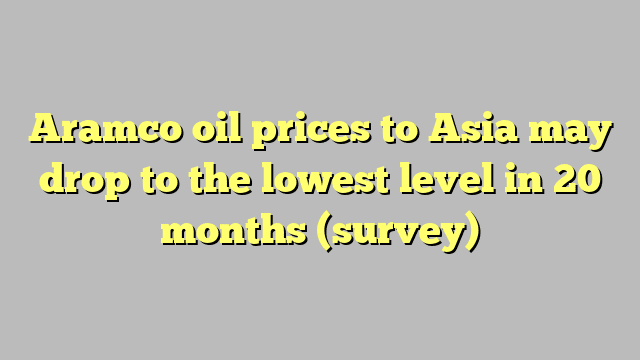A new survey showed that Saudi Aramco oil prices to Asia may decline during the month of June, at a time when the markets are awaiting the next OPEC + meeting to determine production policy, after the decision of the additional voluntary reduction of some coalition countries, which began in May and continues until The end of the current year (2023).
A Reuters poll conducted by the specialized energy platform revealed that the giant state oil company may cut the price of its main Arab Light crude by about $1 per barrel in July.
Hence, the price of Arab Light crude will be set at about $1.55 per barrel above average Oman/Dubai prices, which is the lowest since November 2021.
This will be the second month in a row that Aramco oil prices have fallen to Asia, in light of the decline in oil prices, in addition to expectations of a global economic recession.
Aramco oil prices in june
Aramco cut the selling price of Arab Light crude to Asia by 25 US cents to $2.55 a barrel, above the Oman/Dubai average, according to a pricing document seen by the specialized energy platform.
The reduction in Saudi oil prices came for the first time after 3 consecutive increases in Arab crude prices, which began in March and April, and this May, after their decline to the lowest level in 15 months during February 2023.

The official selling prices for Saudi crude are usually released on the fifth of each month, and set the trend for the prices of Iranian, Kuwaiti and Iraqi crudes, which affects about 9 million barrels per day of crude destined for Asia, according to Reuters.
Aramco sets its crude prices based on customer recommendations, and after calculating the change in the value of its oil over the past month, based on revenues and oil prices.
Reasons for lowering Saudi Aramco prices
One of the participants in the Reuters poll said: “Refining margins in Asian refineries are still weak, and there is still pressure to reduce operating rates.”
Earnings from a typical refinery in Singapore processing Dubai crude recovered to an average of $4.27 a barrel in May, from 81 cents a barrel last month, but still well below $10.42 a barrel in January.
Spot premiums for Middle East crude oil grades declined during the May trading session, as refiners slowed purchases amid expectations of lower demand and margins.
Some Asian refineries are reducing operating rates, while Japan’s Cosmo Oil and Ineos suffer from unit outages that could take months to resume production.
Some Asian refiners have requested less supply from Saudi Aramco for cargoes loaded in June, due to higher OSPs.
OPEC + meeting and the impact of its decisions
OPEC + is scheduled to meet on June 3-4, 2023, to discuss production policy, after Saudi Arabia and 8 other countries in the coalition announced an additional voluntary production cut of 1.16 million barrels per day, starting from May until the end of 2023.
Respondents did not expect that OPEC+ would cut production further.
Another participant said: “The problem is not that there is a lot of oil in the market .. The problem is that the prices are too high.”
The following infographic – prepared by the specialized energy platform – shows the volumes of the additional voluntary reduction of OPEC + countries until the end of the year:

For his part, OPEC Secretary General Haitham Al-Ghais stressed that the Organization of Petroleum Exporting Countries does not aim to set a specific price for oil, but rather aims to achieve a good balance between global supply and demand for crude oil.
Al-Ghais said: “The organization is working to achieve balance in the market, through its decisions and actions,” in response to a question about the impact of voluntary production cuts by some OPEC + countries, during his recent visit to Tehran.
And he stressed that balance in the oil market is a guarantee of achieving stability in everything, according to his statements to the “Shana” news agency affiliated with the Oil Ministry in Iran.
The Secretary General of OPEC welcomed Iran’s full return to the global oil market, upon lifting the sanctions imposed on it by the United States.

Leave a Reply